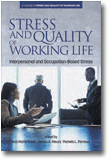
Stress and Quality of Working Life
Interpersonal and Occupation‐Based Stress
Edited by:
Ana Maria Rossi, International Stress Management Association
James A. Meurs, University of Calgary
Pamela L. Perrewé, Florida State University
A volume in the series: Stress and Quality of Working Life. Editor(s): Ana Maria Rossi, International Stress Management Association. Charn P. McAllister, Northern Arizona University. Jeremy D. Mackey, Auburn University.
Published 2015
It is an unfortunate reality that many employees experience elevated levels of stress at work. Feeling stressed has impacts beyond mere emotions. For example, a survey of European Union member states found that 28% of employees reported stress‐related illness or health issues, and studies in the USA have found that over 25% of employees reported that they are often or very often burned out by their work. Also, not all stress should be or can be eliminated, as many industries and jobs are highly demanding in their nature. Therefore, it is important that employees, employers, clinicians, and researchers endeavor to develop a better understanding of workplace stressors and how employee health and well‐being can be improved.
This book can help individuals and organizations better appreciate stressors faced by employees. It showcases research by over two dozen authors in twelve chapters, focusing on the interpersonal and occupation‐based sources of workplace stress, as well as how to alleviate work stress. Coworkers, supervisors, and others with whom a person works can have a dramatic influence on the degree of stress a worker experiences, and it is often the interpersonal conflict that is unrelated to one’s job that is the most difficult to manage. In addition, the context of a person’s work also influences the degree and type of stressors they encounter at work, and this book examines several occupations and their associated stress. We hope that these findings provide ways for individuals and organizations to enhance the well‐being of employees.
CONTENTS
Foreword. Preface. Part I The Role of Interpersonal Interactions in the Stress Process. Lessons From Incivility Research, Michael P. Leiter. Social Aspects of Work: Direct and Indirect Social Messages Conveying Respect or Disrespect, Norbert K. Semmer, Laurenz L. Meier, and Terry A. Beehr. Stress in Online Interview Settings: A Multi‐Study Investigation, Gabriel Giordano, Jason Stoner, Paul M. Di Gangi, and Carmen C. Lewis. Group Atmosphere for Soccer Players in the Junior Team of a Club in Porto Alegre, Brazil, Marcio Geller Marques. Part II Occupation‐Based Stress. Stress and Quality of Life of Medical Doctors: How to Improve This Relation at the Workplace, Rosa Amélia Andrade Dantas. The Relationship between Work Factors and the Frequency of Pain in Administrative/Managerial Professionals, Ilana Calic Bcheche and Zélia Miranda Kilimnik. Work‐Related Stress, Psychological Well‐Being, and Work Engagement: Effects and Relation to Quality of Working Life, Ana Alice Vilas Boas and Estelle M. Morin. Burnout Syndrome and Professional Practice in Psychology, Christian Haag Kristensen, Valquíria Coutinho Tavares, Júlia Candia Donat, and Gustavo Ramos Silva. Part III Managing Stress in the Workplace. Stressful Work and Voluntary Turnover, Marcus J. Fila, Erin Eatough, and Rodger W. Griffeth. Stress Prevention and Management Program for Public Security Professionals, Darlim Saratt Mezomo and Tatiana Saldanha de Oliveira. Managing Employees’ Occupational Stress, Kimberly E. O’Brien and Terry A. Beehr. The Psychologically Healthy Workplace: Fostering Employee Well‐Being and Healthy Businesses, Arla Day, Nikola Hartling, and Blaine Mackie. About the Editors. About the Contributors.
-
Paperback9781681233390
Web price: $45.04 (Reg. 52.99)
-
Hardcover9781681233406
Web price: $80.74 (Reg. 94.99)
- eBook9781681233413

- SEL024000 - SELF HELP: Stress Management
- HEA038000 - HEALTH & FITNESS: Work-Related Health
- PSY036000 - PSYCHOLOGY: Mental Health
-
 Coping and Prevention
Coping and Prevention
-
 Improving Employee Health and Well Being
Improving Employee Health and Well Being
-
 Stress and Quality of Working Life
Finding Meaning in Grief and Suffering
Stress and Quality of Working Life
Finding Meaning in Grief and Suffering
-
 Stress and Quality of Working Life
Coping at Work and at Home
Stress and Quality of Working Life
Coping at Work and at Home
-
 Stress and Quality of Working Life
Current Perspectives in Occupational Health
Stress and Quality of Working Life
Current Perspectives in Occupational Health
-
 Stress and Quality of Working Life
The Positive and The Negative
Stress and Quality of Working Life
The Positive and The Negative
-
 Stress and Quality of Working Life
Conceptualizing and Assessing Stress
Stress and Quality of Working Life
Conceptualizing and Assessing Stress

